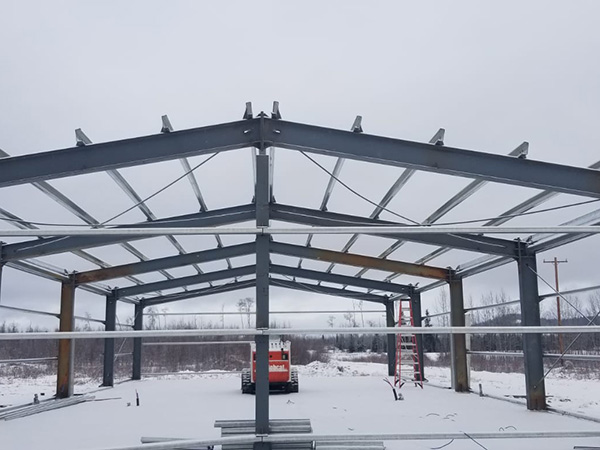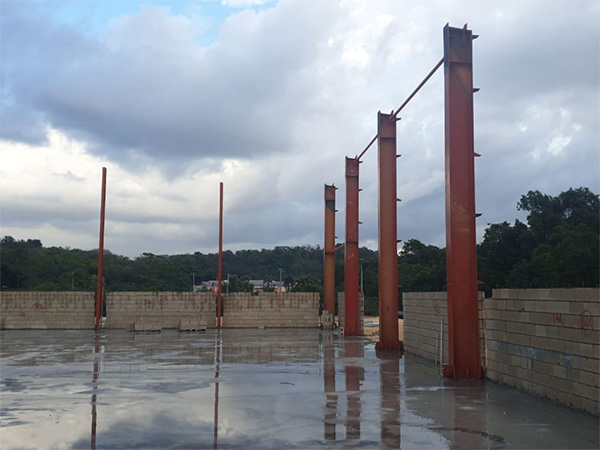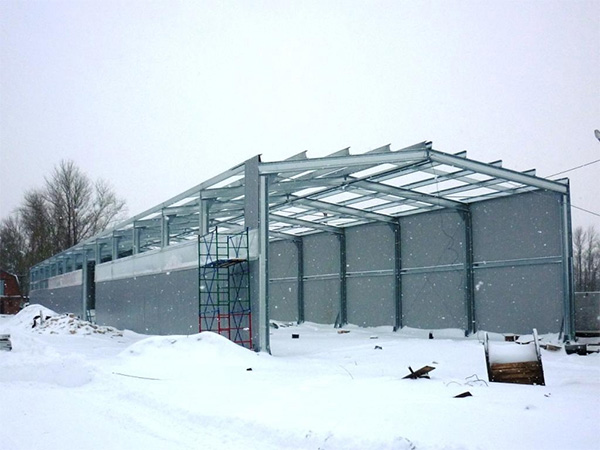Search Product
Search here for what you are looking for:
Search here for what you are looking for:

1. The construction measures in winter are as follows (explained from baiting, construction, assembly, welding, etc.):

1)When the component is blanked, a shrinkage margin should be reserved, and the welding shrinkage and compression deformation should be coordinated with the shrinkage deformation of the steel under negative temperature.
2)When assembling the components, expand the assembly from the inside to the outside according to the order stipulated by the process, and do a test during the assembly at the negative temperature to determine the shrinkage value of the weld that needs to be reserved. Before use, the flux should be baked according to regulations so that its water content does not exceed 0.1%; both ends of a component must not be welded at the same time; unqualified welds should be removed and re-welded, and the application should be carried out in accordance with the requirements of the steel structure welding process at negative temperature weld.
3)When assembling the components, remove the rust, burrs, soil, oil, ice and snow and other debris left in the joint 50mm, and keep the joints dry and free of residual moisture.
4)Welders who participate in the construction of negative temperature steel structures should undergo negative temperature welding process training, pass the examination, and obtain corresponding certificates.
5)Take anti-skid measures when transporting and stacking steel structures in winter, and the component stacking site is flat and solid without puddles, and the ground is free of icing. When the components of the same model are stacked, the components should be kept horizontal, and the shims should be placed on the same vertical line to prevent the components from slipping.
6)When using steel cables to hoist steel components, anti-skid spacers should be added, the gusset plate that is hoisted at the same time as the components, and the fixtures needed by the installer should be tied firmly with ropes.
7)When steel components are installed at positive temperature and at negative temperature, the shrinkage of components should be considered according to the difference in ambient temperature, and technical measures to adjust deviation should be taken during construction.
8)The welding rod used under negative temperature shall not be exposed for more than 2 hours, and it shall be re-baked after more than 2 hours. The number of baking of the welding rod shall not exceed 3 times. The steel and related connecting materials used under negative temperature must be accompanied by a quality certificate, whose performance meets the requirements of design and product standards; the columns and main beams installed at negative temperature shall be corrected immediately, and the position correction shall be correct and immediately fixed permanently. Components installed on the same day shall A stable space system is formed; water-based coatings must not be used for the coatings used for steel structures at negative temperatures; high-strength bolts used at negative temperatures must have a product certificate, and the torque coefficient and axial force must be re-inspected under negative temperature.
9)When the high-strength bolt joint is installed, there must be no snow or ice on the friction surface of the component, and no contact with dirt, oil and other stolen goods.
10)Compile a diagram of the installation sequence of steel components according to the temperature conditions, and perform installation in strict accordance with the specified sequence during construction. Before installation, remove ice, snow and dew on the surface of the components, but do not damage the coating. During installation, in case of snow or wind speed above 6m/s, set up a protective shed
11)When the ambient temperature is lower than 0°C, perform the painting process test before applying the anticorrosive coating. When painting, the rust, oil stains, burrs, etc. on the surface of the component must be cleaned up, and the surface must be kept dry. No painting work is allowed in snowy weather or when there is thin ice on the components.
12)Before the steel structure is installed, its quality shall be re-inspected according to the requirements under negative temperature conditions, and the components that have been missed during production and deformed during transportation and stacking shall be repaired and corrected on the ground. In addition to complying with the requirements of "Code for Construction and Acceptance of Steel Structure Engineering" (GB50250-95), the quality of steel structure installation under negative temperature should also be inspected and accepted according to design requirements.
2. The construction measures in rainy season are as follows:

1) When hoisting, if there is water on the component, it should be cleaned before installation, but the coating should not be damaged. When the high-strength bolt joint is installed, the friction surface of the component should be clean, there should be no water drops, let alone rain, soil and oil. Wait for dirt.
2) Because the air is relatively humid in rainy days, the storage of welding rods should be moisture-proof and baked. The number of repeated baking of the same welding rod should not exceed twice, and the management personnel should make a record of baking in time; components cannot be painted in rainy weather; rainy days and five High winds above grade level cannot carry out roof insulation construction.
3) When construction in rainy days, temporary shelters should be set up, and rainwater should not fall on the hot welds. If the welding parts are wet, they must be wiped with a dry cloth and dried with an oxyacetylene flame before welding to keep the joints dry. There is no residual moisture.
4)In the event of windy weather, large components such as columns, main beams, and supports should be corrected immediately, and permanent fixation should be performed immediately after the correct position is corrected to prevent unilateral instability. The components installed on the same day should form a space stability system.



